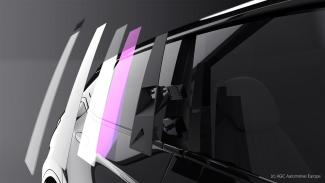Wideye® by AGC to display LiDAR sensor mounted in B-pillar at AutoSens show in Brussels
Wideye – in collaboration with Sony Depthsensing Solutions – has successfully incorporated a Time of Flight (ToF) camera in a vehicle B-pillar. The prototype will be demonstrated at the AutoSens show, from 12 to 14 September in Brussels.
As the automotive market relentlessly evolves towards autonomous vehicles, more and more sensors will be installed in vehicles. Integration is critically important: the sensors must be able to perform efficiently at all times, the system must be reliable and the overall look must be aesthetically pleasing – a triple challenge which Wideye and Sony Depthsensing Solutions (“SDS”) jointly addressed by integrating a Time-of-Flight (ToF) camera, which is a type of scanner-less LiDAR, in the B-pillar. The market has started to install cameras and radar sensors – but until now, not LiDAR sensors – in the B-pillar since it is the ideal location for ADAS and telematics functionalities, such as parking space detection, facial recognition required for access control, lane detection and more.
Wideye and SDS decided to join forces on a project to integrate a LiDAR sensor in the B-pillar, ultimately developing a prototype that combines SDS’s sensor with Wideye glass. SDS contributed a ToF camera whose specifications were ideal for this location, delivering high resolution, a wide field of view and a short detection range. Wideye provided glass perfectly optimised for the ToF camera. The glass is transparent to infrared rays and can be assembled aesthetically into the B-pillar thanks to its glossy black appearance. One of the major benefits of Wideye glass over plastic solutions and other glass products on the market is its unique combination of excellent optical transmission and performance, robustness and reliability, all of which are necessary for this kind of exterior application.
The prototype will be on display at the AutoSens show, where the complete “Use Case” document describing this collaboration will be revealed. The document will be available as of 17 September at: https://wideye.vision/newsroom/.
Through its collaboration with SDS, Wideye aims to leverage its automotive glass expertise and supply the industry with end-to-end integrated and validated solutions.
"Wideye's strategy is to develop expertise and competence through collaborative partnerships with key partners in order to deliver best-in-class solutions while sharing development capabilities and resources. Our key goals are to develop integrated glass/sensor solutions, deliver optimum performance, reduce development time and lower costs," according to Wideye CEO Quentin Fraselle.
Share this page
Wideye® by AGC
Katia Hansen
Marketing & Communication Manager
Mobile: +32 486 89 35 16
katia.hansen@agc.com
About Wideye® by AGC
Totally focused on autonomous vehicle ecosystems, Wideye® by AGC is a corporate scale-up of the Tokyo-based AGC Group, a world-leading supplier of flat, automotive and display glass, chemicals and other high-tech materials and components. Wideye® by AGC is backed by AGC Automotive Europe, AGC Group’s European automotive glass branch, which specialises in the production of glazing solutions for carmakers.
Since its launch in 2016, Wideye has focused on enabling ADAS deployment and making fully autonomous driving a reality.
Through comprehensive R&D and partnerships with sensor companies, Wideye has developed the know-how to deliver 360° sensor integration from the early development stage up through mass production. It is aiming to provide its innovative services and products at sensor suppliers, automotive tier 1 suppliers and OEMs by working in close collaboration with them. Wideye is deploying its broad ecosystem to help its customers design, prototype and industrialise perfect integration solutions for their optical sensor modules, such as LiDAR and cameras.
For more information go to: www.wideye.vision or join us on LinkedIn.
